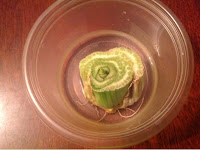
One of the books that I read this summer was Thomas Hager's
The Alchemy of Air. This was a fascinating piece of writing mixing science, history and biography in a well woven tale about one of the essential elements of life. Nitrogen is needed for the production of amino and nucleic acids which all living things require. Our planet's atmosphere is 78% nitrogen yet with the rare exception of some bacteria found in soil and cyanobacteria/algae in aquatic ecosystems, living organisms can not use this inert gas directly. Through the activity of nitrogen fixation and the formation of nitric oxide from atmospheric nitrogen and oxygen gases using the energy from lightning to drive the reaction, nitrogen takes on a form that plants and other photosynthetic organisms can absorb and convert into amino and nucleic acids. Nitrogen is returned to the atmosphere by the activity of decomposing bacteria.
You're wondering where the book comes in. At the turn of the twentieth century the call went out to find a way to synthesize nitrogen based fertilizers to help feed the growing human population. I bet they never thought we would reach the 7 billion now on the planet, but I digress. The point being that Fritz Haber took up the challenge and designed a way to convert nitrogen and hydrogen gases into ammonia. It took the genius of Carl Bosch to engineer the necessary equipment to make it possible to make ammonia in a profitable large scale way. Today the Haber-Bosch process continues to produce the majority of inorganic fertilizers used in agriculture. According to Hager 50% of the nitrogen in our bodies comes from this process and from the foods we have consumed which have been at one time treated with fertilizers.
The problem now is too much nitrogen in the cycle. Excess nitrogen from fertilizers now enters into the soil and water systems. Eutrophication of lakes and the ocean occurs from the over growth of algae which impacts the oxygen levels of the water and kills other aquatic life. Excess nitric oxide in the atmosphere contributes to the formation of acid rain which can lead to pH changes in soil and bodies of water impacting the plants and animals in the affected regions. Too much of a good thing can be a problem.
My Ecology class recently did a unit on the geochemical cycles and we discussed the impact of human activity on the nitrogen cycle. The focus has been on the carbon cycle and climate change, that the nitrogen cycle and its disruption often goes unnoticed. The nitrogen cycle's disruption may become part of the next major ecological worries. The background knowledge I gained from this book allowed me to share how science and the development also played a role in the course of history primarily World War II when the Nazi war machine used the technology developed by Haber and Bosch to make synthetic fuel.








